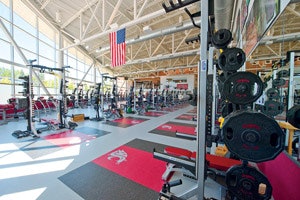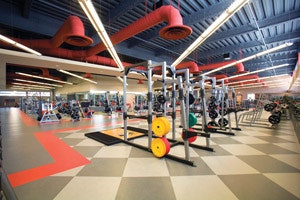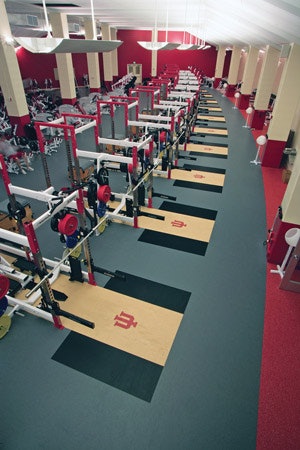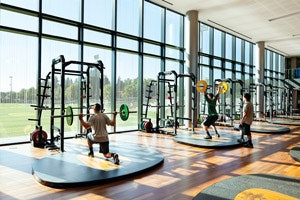 Washington State University Weight Room
Washington State University Weight Room
When the University of Oregon formally unveiled its new $68 million football performance center, the Hatfield-Dowlin Complex, last summer, it redefined athletic luxury on the collegiate level. Designed by Portland-based ZGF Architects LLP, amenities include a players lounge with Italian leather furniture, rugs hand-woven in Nepal and customized gaming systems; a space-age locker room that requires a biometric thumbprint to enter; and a 25,000-square-foot weight room fortified with Brazilian Ipe wood floors. Environmentally friendly, this type of flooring is mold-, fire-, weather- and pest-resistant, and its strength is comparable to that of steel.
"When I was younger, almost all the weight rooms were on wood floors. They would put these old thick black livestock mats over the areas where there were free weights," says Steve Chase, president of Fitness Floors. "This is kind of the same thing, although much more artistically done. The wood floor is protected by thick rubber mats in the shape of an 'O' where the weights have a possibility of being dropped. It should work fairly well, unless a dropped weight finds a way to roll off the mat."
While aesthetically breathtaking and a boon for recruiting, the floor's functionality and how it will be maintained over the years is unknown. However, the Oregon weight room symbolizes the evolving nature of weight room flooring. While most colleges and universities do not have the same fiscal might that the University of Oregon has with Nike founder and billionaire Phil Knight in its corner, they are committing the necessary resources to branding their weight room flooring for recruiting purposes, while also transforming their weight rooms into vibrant spaces. But aesthetic needs aside, schools and rec centers are also focusing more on their weight room flooring as they prioritize the user's safety and performance, while also being cognizant of the bacteria, including MRSA, lurking beneath that flooring.
 Univ Nevada Las Vegas Weight Room
Univ Nevada Las Vegas Weight Room
WARNING SIGNS
Specifying weight room flooring used to be pretty simple: 3⁄8-inch speckled rubber sold in rolls or in interlocking or square tiles. But today, flooring thickness can vary based on environment. A thinner floor installed in a health club can last 10 to 20 years, but if that same flooring were to be installed in a college athletic area, that lifespan could be cut in half. There is also the issue of spaces requiring different flooring. Cardiovascular areas do not require strong shock absorption, so thinner flooring typically will suffice. While weight training areas, including those with selectorized equipment, require thicker flooring that can handle the impact from dropping weights and weight stacks, there are also functional training zones, which have their own requirements. Each presents their own challenges, including the damage sustained by dropped weights.
"When hex head weights and iron kettlebells are dropped, they will cut through virtually anything over time," says Chase. "Once the surface starts getting cut, it starts to become a tripping hazard, especially if the weights are dropped in the same area repeatedly."
Former Purdue football offensive coordinator Gary Nord sued the university last year for negligence after tripping on the flooring in the Mackay Arena weight room in 2012 and sustaining a severe back injury. And most recently, the Grambling State football team walked out on its school last summer, due in part to its unsafe weight room that featured large interlocking rubber tiles that had turned light gray, were curling at the edges or had corners missing.
 University of Indiana Weight Room
University of Indiana Weight Room
There are some obvious signs that a weight room floor needs to replaced, starting with visible holes. "You can look and see that the flooring has either worn through to the subfloor or has at least taken so many impacts in the same area that the flooring is starting to crumble in that area," says Chase. "Another visible sign in the case of tiles and rolls, if the seams are starting to curl or shrink to such a degree that they are becoming a tripping point."
A less obvious sign is resiliency. "Floors with a black background can have wear paths in them that can't be easily determined, but they can soon be worn through or permanently torn with a dropped weight," Chase continues.
"When you're throwing heavy weights or heavy dumbbells on the floor, the floor doesn't have the memory in it to come back — so when it bends, it's not coming back," says Brett Waits, president of performance flooring manufacturer PLAE. "Weight room flooring must be designed for extreme use and high traffic, and must be durable long-term while maintaining its appearance."
Weight room flooring may also need replacing if moisture gets into substrate slabs, causing the flooring to start to bubble, which in turn creates a safety or tripping hazard. And then there are simply parts of a floor that need to be replaced due to training. Explains Waits, "These weight rooms will have certain neighborhoods where they are doing more dynamic training, such as plyometrics. From a replacement standpoint, they may know if they have moisture or bubbles, if it's thinning or cutting, but what they might not know is when to update their floor off of this type of exercise."
 POWER BOOST
POWER BOOST
The Brazilian IPE wood floors installed in the University of Oregon’s new weight room are environmentally friendly while boasting strength similar to steel. (Photo By Jeremy Bitterman/University of Oregon Hatfield-Dowlin Complex)
INSTALLATION CONSIDERATONS
When installing or replacing weight room flooring, facility managers must prioritize health and safety. Not only must flooring protect users from injuries, but from infections, as well. "Ten years ago, MRSA was never a question, but today, seven out of 10 people ask if the flooring is MRSA-resistant," says Glenn Hoy, regional sales manager with Mondo. Any weight room floor being considered should be easy to clean, handle a lot of traffic and, most important, be non-porous, according to Hoy.
"Non-porous will keep down the odor and make it easier to clean, and it will help mitigate the spread of bacteria and infection," he says. "The floors that typically work that way are a sheet vinyl, a vulcanized rubber or recycled rubber that's sealed." Hoy also warns of the dangers of flooring being incorrectly installed.
"Incorrect installation can lead to premature wear and allow cleaning and/or body fluid to accumulate underneath," says Hoy. "Good flooring, installed correctly on a properly prepared subfloor, is not a luxury, it is a necessity."
 Installation Checklist
Installation Checklist
Noise is another key consideration when installing or replacing flooring. Flooring must play a role in decreasing decibel levels, making that space more inviting to members. "It's about maximizing the versatility and the functionality of the space," says Waits.
One increasingly popular exercise putting more stress on flooring is CrossFit. In the past, many health clubs and recreation centers may have opted for thinner flooring, but exercises with intense movements, such as CrossFit's Olympic lifts performed in rapid fashion, have forced these facilities to reexamine their flooring. "Today, these facilities are typically looking for thicker rubber floors because they are doing quick repetitions with very heavy weights, often using things such as kettlebells," says Chase. "Since the object is to typically do as many repetitions in a certain amount of time, the weights are thrown around pretty quickly and there is a higher propensity for them to be dropped. This necessitates a thicker flooring surface, which is harder to damage."
The demands on weight room floors have changed over the years. Today, there could be one large space devoted to CrossFit, dumbbells, treadmills and plyometrics — each with their own unique demands. "When you're designing these facilities, you need to make sure you're purchasing the product for the right application," says Waits. "That's the key in today's environment."
This article originally appeared in the January 2014 issue of Athletic Business under the headline, "Pounds of Prevention."
































